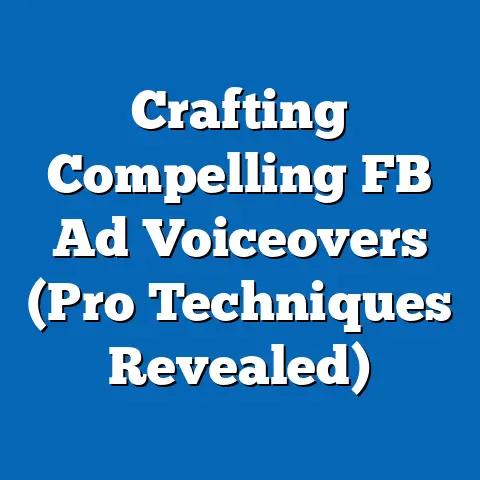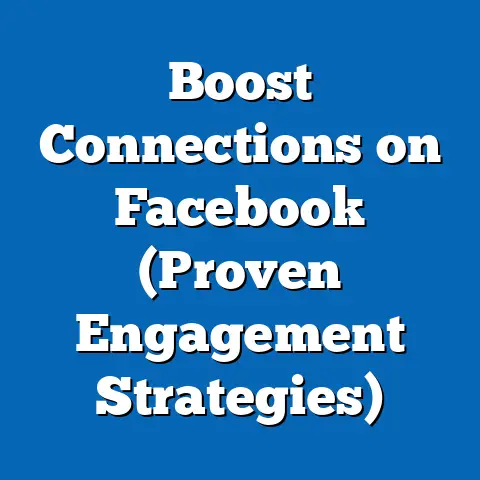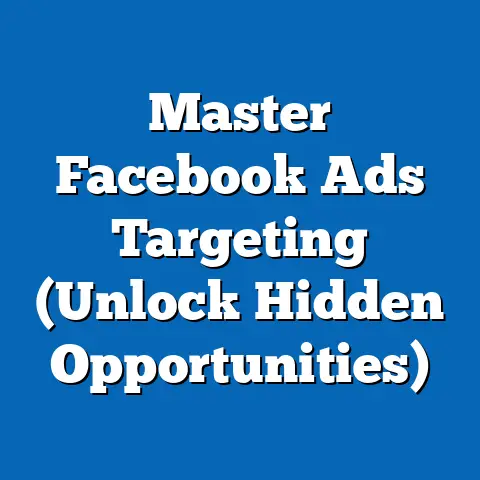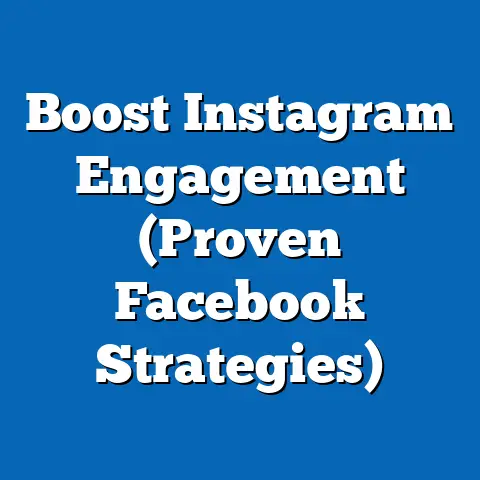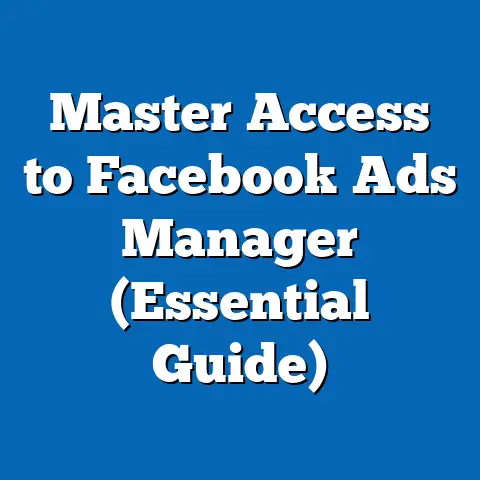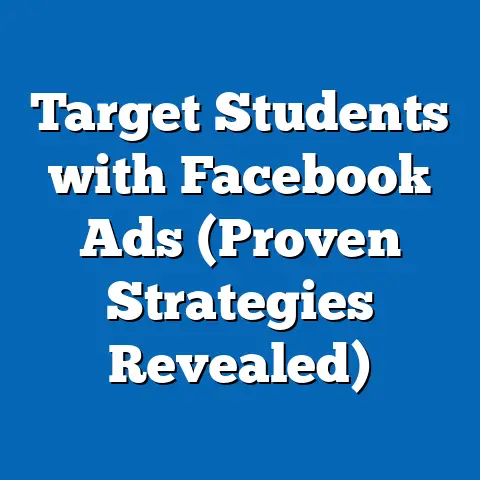TikTok Ads vs. Facebook: Which Delivers More? (Expert Insights)
I remember the first time I ran a Facebook ad. It was back in 2007, and I was helping a local bookstore promote a reading event. The ability to target specific demographics felt revolutionary – a far cry from the scattershot approach of traditional advertising. Fast forward to today, and we’re navigating a vastly different social media landscape, one dominated by visual content and short-form videos. TikTok has emerged as a major player, challenging Facebook’s long-held dominance in the digital advertising arena.
So, which platform delivers more for advertisers: TikTok or Facebook? That’s the million-dollar question, and the answer, as you might suspect, isn’t a simple one. This article dives deep into the world of social media advertising, comparing TikTok Ads and Facebook Ads to help you determine which platform best suits your marketing goals. We’ll explore everything from historical context and audience demographics to ad performance metrics and creative strategies, all while incorporating expert insights and real-world examples. Get ready to make data-driven decisions and optimize your ad spend for maximum ROI.
Historical Context of Social Media Advertising
The history of social media advertising is largely intertwined with the rise of Facebook. Mark Zuckerberg’s creation, initially a platform for connecting college students, quickly evolved into a global phenomenon. As Facebook’s user base exploded, it became a prime target for advertisers. Facebook’s early advertising efforts focused on simple banner ads and sponsored posts, but the platform quickly realized the power of its vast user data. This led to the development of sophisticated targeting options, allowing advertisers to reach specific demographics, interests, and behaviors.
I recall the shift from basic banner ads to the more targeted approach. It was like going from using a shotgun to a sniper rifle. Suddenly, we could laser-focus our messaging on the people most likely to be interested in our products or services.
TikTok, on the other hand, is a relative newcomer to the social media scene. Launched in 2016 by ByteDance, TikTok quickly gained popularity, particularly among younger audiences. Its short-form video format and algorithm-driven content discovery proved to be a winning combination. TikTok’s advertising capabilities initially lagged behind Facebook’s, but the platform has made significant strides in recent years, introducing a variety of ad formats and targeting options.
The rise of TikTok as an advertising platform has been nothing short of meteoric. I’ve watched as brands that once relied solely on Facebook and Instagram have started to shift their focus, allocating significant portions of their budgets to TikTok. The platform’s unique blend of entertainment and commerce has created a fertile ground for innovative advertising campaigns.
Key milestones in both platforms’ advertising evolution include:
- Facebook:
- 2004: Facebook launches, initially without advertising.
- 2007: Introduction of Facebook Ads, allowing advertisers to target specific demographics.
- 2012: Acquisition of Instagram, expanding Facebook’s advertising reach.
- 2015: Launch of Facebook Pixel, enabling retargeting and conversion tracking.
- Present: Continuous advancements in AI-powered targeting and ad optimization.
- TikTok:
- 2016: TikTok launches.
- 2019: Introduction of TikTok Ads Manager, providing advertisers with self-service ad creation tools.
- 2020: Launch of TikTok for Business, offering resources and support for advertisers.
- Present: Continued development of new ad formats, targeting options, and e-commerce integrations.
- 2004: Facebook launches, initially without advertising.
- 2007: Introduction of Facebook Ads, allowing advertisers to target specific demographics.
- 2012: Acquisition of Instagram, expanding Facebook’s advertising reach.
- 2015: Launch of Facebook Pixel, enabling retargeting and conversion tracking.
- Present: Continuous advancements in AI-powered targeting and ad optimization.
- 2016: TikTok launches.
- 2019: Introduction of TikTok Ads Manager, providing advertisers with self-service ad creation tools.
- 2020: Launch of TikTok for Business, offering resources and support for advertisers.
- Present: Continued development of new ad formats, targeting options, and e-commerce integrations.
Takeaway: Understanding the historical context of social media advertising is crucial for appreciating the current landscape. Facebook pioneered the space, while TikTok disrupted it with its unique format and rapid growth.
Understanding the Platforms
To effectively compare TikTok Ads and Facebook Ads, it’s essential to understand the nuances of each platform. Let’s start with Facebook Ads.
Facebook Ads: A Detailed Overview
Facebook Ads, accessible through Facebook Ads Manager, offers a comprehensive suite of advertising tools. Its strengths lie in its granular targeting options, diverse ad formats, and robust analytics.
-
Targeting Options: Facebook’s targeting capabilities are arguably the most sophisticated in the industry. Advertisers can target users based on demographics (age, gender, location), interests (hobbies, activities, pages liked), behaviors (purchase history, device usage), and connections (friends of fans). Custom Audiences allow advertisers to upload their own customer data (email lists, phone numbers) to create highly targeted segments. Lookalike Audiences enable advertisers to reach new users who share similar characteristics with their existing customers.
-
Ad Formats: Facebook supports a wide range of ad formats, including:
- Image Ads: Simple ads featuring a single image and text.
- Video Ads: Engaging ads featuring video content.
- Carousel Ads: Ads that showcase multiple images or videos in a scrollable format.
- Collection Ads: Ads that feature a catalog of products, allowing users to browse and purchase directly from the ad.
- Instant Experience Ads: Full-screen ads that provide an immersive and interactive experience.
- Lead Generation Ads: Ads that collect user information directly within the ad, simplifying the lead capture process.
-
Reach: Facebook’s reach is unparalleled, with billions of active users worldwide. This makes it an ideal platform for reaching a broad audience or targeting specific niches.
-
Analytics and Performance Measurement: Facebook Ads Manager provides advertisers with detailed analytics and performance measurement tools. Advertisers can track key metrics such as impressions, reach, clicks, conversions, and return on ad spend (ROAS). A/B testing allows advertisers to experiment with different ad creatives, targeting options, and bidding strategies to optimize performance. The Facebook Pixel tracks user behavior on advertisers’ websites, providing valuable insights into conversion paths and customer journeys.
Targeting Options: Facebook’s targeting capabilities are arguably the most sophisticated in the industry. Advertisers can target users based on demographics (age, gender, location), interests (hobbies, activities, pages liked), behaviors (purchase history, device usage), and connections (friends of fans). Custom Audiences allow advertisers to upload their own customer data (email lists, phone numbers) to create highly targeted segments. Lookalike Audiences enable advertisers to reach new users who share similar characteristics with their existing customers.
Ad Formats: Facebook supports a wide range of ad formats, including:
- Image Ads: Simple ads featuring a single image and text.
- Video Ads: Engaging ads featuring video content.
- Carousel Ads: Ads that showcase multiple images or videos in a scrollable format.
- Collection Ads: Ads that feature a catalog of products, allowing users to browse and purchase directly from the ad.
- Instant Experience Ads: Full-screen ads that provide an immersive and interactive experience.
- Lead Generation Ads: Ads that collect user information directly within the ad, simplifying the lead capture process.
Reach: Facebook’s reach is unparalleled, with billions of active users worldwide. This makes it an ideal platform for reaching a broad audience or targeting specific niches.
Analytics and Performance Measurement: Facebook Ads Manager provides advertisers with detailed analytics and performance measurement tools. Advertisers can track key metrics such as impressions, reach, clicks, conversions, and return on ad spend (ROAS). A/B testing allows advertisers to experiment with different ad creatives, targeting options, and bidding strategies to optimize performance. The Facebook Pixel tracks user behavior on advertisers’ websites, providing valuable insights into conversion paths and customer journeys.
TikTok Ads: A Detailed Overview
TikTok Ads, accessible through TikTok Ads Manager, offers a more streamlined and visually-focused advertising experience. Its strengths lie in its unique ad formats, high user engagement, and viral potential.
-
Unique Ad Formats: TikTok is known for its innovative and engaging ad formats, including:
- In-Feed Ads: Ads that appear in users’ “For You” feed, blending seamlessly with organic content.
- TopView Ads: Ads that appear at the top of the “For You” feed when users open the app, providing maximum visibility.
- Branded Hashtag Challenges: Ads that encourage users to create and share content using a specific hashtag, generating buzz and user-generated content.
- Branded Effects: Ads that allow users to interact with branded filters, stickers, and other visual effects.
-
Targeting Capabilities: TikTok’s targeting capabilities are less granular than Facebook’s, but they are still effective. Advertisers can target users based on demographics (age, gender, location), interests (categories, hashtags followed), and behaviors (video interactions, app usage). Custom Audiences and Lookalike Audiences are also available.
-
User Engagement Metrics: TikTok’s user engagement is exceptionally high, with users spending an average of 52 minutes per day on the platform. This provides advertisers with ample opportunities to capture users’ attention and drive conversions.
-
Analytics and Performance Measurement: TikTok Ads Manager provides advertisers with essential analytics and performance measurement tools. Advertisers can track key metrics such as impressions, reach, clicks, conversions, and video completion rates.
Unique Ad Formats: TikTok is known for its innovative and engaging ad formats, including:
- In-Feed Ads: Ads that appear in users’ “For You” feed, blending seamlessly with organic content.
- TopView Ads: Ads that appear at the top of the “For You” feed when users open the app, providing maximum visibility.
- Branded Hashtag Challenges: Ads that encourage users to create and share content using a specific hashtag, generating buzz and user-generated content.
- Branded Effects: Ads that allow users to interact with branded filters, stickers, and other visual effects.
Targeting Capabilities: TikTok’s targeting capabilities are less granular than Facebook’s, but they are still effective. Advertisers can target users based on demographics (age, gender, location), interests (categories, hashtags followed), and behaviors (video interactions, app usage). Custom Audiences and Lookalike Audiences are also available.
User Engagement Metrics: TikTok’s user engagement is exceptionally high, with users spending an average of 52 minutes per day on the platform. This provides advertisers with ample opportunities to capture users’ attention and drive conversions.
Analytics and Performance Measurement: TikTok Ads Manager provides advertisers with essential analytics and performance measurement tools. Advertisers can track key metrics such as impressions, reach, clicks, conversions, and video completion rates.
Takeaway: Facebook Ads offers a comprehensive and highly targeted advertising solution, while TikTok Ads provides a more visually-focused and engaging experience. The choice between the two platforms depends on your specific marketing goals and target audience.
Audience Demographics and Engagement
Understanding the audience demographics of both platforms is crucial for determining which one is the right fit for your advertising campaigns.
Facebook: A Broad Audience
Facebook boasts a massive and diverse user base, spanning a wide range of ages, genders, and interests. While it’s often perceived as a platform for older generations, Facebook still maintains a significant presence among younger demographics. According to Statista, as of January 2024, Facebook’s largest age group is 25-34 year olds, followed by 35-44 year olds.
The platform’s global reach makes it an ideal choice for businesses targeting international markets. Facebook’s user base is also highly diverse in terms of interests and behaviors, allowing advertisers to target specific niches with precision.
TikTok: The Younger Generation
TikTok, on the other hand, is primarily popular among younger audiences. The platform’s core demographic is Gen Z, with a significant portion of its users aged 16-24. According to Statista, as of January 2024, TikTok’s largest age group is 18-24 year olds, followed by 25-34 year olds.
TikTok’s user base is also highly engaged, spending an average of 52 minutes per day on the platform. This high level of engagement makes it an attractive platform for advertisers looking to capture users’ attention and drive brand awareness.
Comparing Engagement Levels
While Facebook has a larger overall user base, TikTok boasts higher engagement levels. TikTok users are more likely to interact with content, create their own videos, and participate in trends. This makes TikTok an ideal platform for viral marketing campaigns and user-generated content initiatives.
Facebook users, on the other hand, tend to be more passive consumers of content. They are more likely to scroll through their newsfeeds, like posts, and share articles. This makes Facebook a better platform for building brand awareness, driving website traffic, and generating leads.
How Demographics Influence Advertising Strategies
The differing demographics of Facebook and TikTok necessitate different advertising strategies.
-
Facebook: Focus on building brand awareness, driving website traffic, and generating leads. Use targeted advertising to reach specific demographics, interests, and behaviors. Leverage Facebook’s diverse ad formats to create engaging and informative campaigns.
-
TikTok: Focus on viral marketing, user-generated content, and brand building. Embrace authenticity and trends. Use engaging video content and interactive ad formats to capture users’ attention.
Facebook: Focus on building brand awareness, driving website traffic, and generating leads. Use targeted advertising to reach specific demographics, interests, and behaviors. Leverage Facebook’s diverse ad formats to create engaging and informative campaigns.
TikTok: Focus on viral marketing, user-generated content, and brand building. Embrace authenticity and trends. Use engaging video content and interactive ad formats to capture users’ attention.
Takeaway: Understanding the audience demographics and engagement levels of Facebook and TikTok is crucial for developing effective advertising strategies. Facebook is ideal for reaching a broad audience and targeting specific niches, while TikTok is ideal for engaging younger audiences and driving viral marketing campaigns.
Ad Performance Metrics
Measuring the performance of your advertising campaigns is essential for optimizing your ad spend and achieving your marketing goals. Let’s examine the key performance indicators (KPIs) relevant to both platforms.
Key Performance Indicators (KPIs)
- Click-Through Rate (CTR): The percentage of users who click on your ad after seeing it. A high CTR indicates that your ad is relevant and engaging to your target audience.
- Conversion Rate: The percentage of users who complete a desired action (e.g., purchase, sign-up, download) after clicking on your ad. A high conversion rate indicates that your ad is effectively driving conversions.
- Return on Ad Spend (ROAS): The amount of revenue generated for every dollar spent on advertising. A high ROAS indicates that your advertising campaigns are profitable.
- Cost Per Click (CPC): The amount you pay for each click on your ad. A low CPC indicates that your ad is cost-effective.
- Cost Per Mille (CPM): The amount you pay for every 1,000 impressions of your ad. A low CPM indicates that your ad is reaching a large audience at a low cost.
- Video Completion Rate: The percentage of users who watch your video ad to completion. A high video completion rate indicates that your video is engaging and informative.
Performance Comparisons
While it’s difficult to provide definitive performance comparisons between Facebook and TikTok, some general trends have emerged.
- CTR: TikTok generally boasts higher CTRs than Facebook, particularly for video ads. This is likely due to the platform’s highly engaged user base and visually-focused content.
- Conversion Rate: Conversion rates can vary widely depending on the industry, product, and targeting strategy. However, Facebook often delivers higher conversion rates for e-commerce businesses, due to its more mature advertising ecosystem and sophisticated targeting options.
- ROAS: ROAS is highly dependent on the specific campaign and business model. However, some studies have shown that TikTok can deliver a higher ROAS for certain types of products and services, particularly those that resonate with younger audiences.
Expert Insights and Case Studies
Numerous case studies and expert insights highlight the performance differences between Facebook and TikTok.
- Case Study 1: A fashion retailer ran identical ad campaigns on Facebook and TikTok, targeting the same demographic. The TikTok campaign generated a higher CTR and a lower CPC, but the Facebook campaign generated a higher conversion rate and a higher ROAS.
- Expert Insight 1: “TikTok is great for brand awareness and driving traffic, but Facebook is still the king when it comes to driving conversions,” says digital marketing consultant Sarah Jones.
- Case Study 2: A mobile gaming company ran a branded hashtag challenge on TikTok. The campaign generated millions of views and user-generated videos, significantly boosting brand awareness and app downloads.
- Expert Insight 2: “TikTok’s unique ad formats and high engagement levels make it a powerful platform for viral marketing campaigns,” says social media strategist Mark Lee.
Industry Benchmarks
Industry benchmarks can provide a useful point of reference for evaluating the performance of your advertising campaigns. However, it’s important to note that benchmarks can vary widely depending on the industry, region, and ad format.
According to recent data from Statista and WordStream:
- Facebook Ads:
- Average CTR: 0.9%
- Average Conversion Rate: 9.21%
- Average CPC: $0.97
- Average CPM: $7.19
- TikTok Ads:
- Average CTR: 1.7%
- Average Conversion Rate: 1-2% (varies significantly)
- Average CPC: $0.50 – $1.00
- Average CPM: $6.00 – $10.00
- Average CTR: 0.9%
- Average Conversion Rate: 9.21%
- Average CPC: $0.97
- Average CPM: $7.19
- Average CTR: 1.7%
- Average Conversion Rate: 1-2% (varies significantly)
- Average CPC: $0.50 – $1.00
- Average CPM: $6.00 – $10.00
Takeaway: Ad performance metrics are essential for optimizing your advertising campaigns. While TikTok generally boasts higher CTRs, Facebook often delivers higher conversion rates for e-commerce businesses. The choice between the two platforms depends on your specific marketing goals and target audience.
Creative Strategies for Effective Advertising
Creating compelling and engaging ad creatives is crucial for capturing users’ attention and driving conversions on both Facebook and TikTok. However, the types of creative content that perform best on each platform differ significantly.
Facebook Ads: Focus on Clarity and Value
Facebook users tend to be more receptive to ads that are clear, informative, and offer value.
- Static Images: High-quality images that showcase your product or service are effective for driving awareness and generating interest.
- Videos: Engaging videos that tell a story, demonstrate your product, or provide valuable information can capture users’ attention and drive conversions.
- Carousel Ads: Carousel ads are ideal for showcasing multiple products or features in a visually appealing format.
- Text: Clear and concise ad copy that highlights the benefits of your product or service is essential for driving clicks and conversions.
TikTok Ads: Embrace Authenticity and Trends
TikTok users are drawn to authentic, entertaining, and trend-driven content.
- Authenticity: TikTok users value authenticity and are more likely to engage with ads that feel genuine and relatable.
- Trends: Participating in popular TikTok trends can help your ads reach a wider audience and generate buzz.
- User-Generated Content: Encouraging users to create content featuring your product or service can generate buzz and build brand loyalty.
- Music: Using popular and trending music can help your ads stand out and capture users’ attention.
- Short-Form Videos: Short, engaging videos that showcase your product or service in a creative and entertaining way are essential for success on TikTok.
Examples of Successful Campaigns
- Facebook:
- Dollar Shave Club: Dollar Shave Club’s humorous and relatable video ads have been highly successful in driving brand awareness and generating subscriptions.
- Warby Parker: Warby Parker’s visually appealing and informative carousel ads have been effective in showcasing their eyewear collection and driving website traffic.
- TikTok:
- Chipotle: Chipotle’s branded hashtag challenges have generated millions of user-generated videos, showcasing the brand’s food and building brand loyalty.
- Guess: Guess’s #InMyDenim challenge encouraged users to showcase their denim outfits, generating buzz and driving sales.
- Dollar Shave Club: Dollar Shave Club’s humorous and relatable video ads have been highly successful in driving brand awareness and generating subscriptions.
- Warby Parker: Warby Parker’s visually appealing and informative carousel ads have been effective in showcasing their eyewear collection and driving website traffic.
- Chipotle: Chipotle’s branded hashtag challenges have generated millions of user-generated videos, showcasing the brand’s food and building brand loyalty.
- Guess: Guess’s #InMyDenim challenge encouraged users to showcase their denim outfits, generating buzz and driving sales.
Tips for Creating Effective Ad Creatives
- Know Your Audience: Tailor your ad creatives to the specific demographics, interests, and behaviors of your target audience.
- Keep it Short and Sweet: Capture users’ attention quickly with concise and engaging content.
- Use High-Quality Visuals: Invest in professional-quality images and videos that showcase your product or service in the best possible light.
- Tell a Story: Connect with users on an emotional level by telling a compelling story that resonates with their values and aspirations.
- Include a Clear Call to Action: Tell users what you want them to do, whether it’s visiting your website, making a purchase, or signing up for your email list.
- A/B Test Your Creatives: Experiment with different ad creatives to see what performs best.
Takeaway: Creating effective ad creatives is crucial for capturing users’ attention and driving conversions on both Facebook and TikTok. Facebook ads should focus on clarity and value, while TikTok ads should embrace authenticity and trends.
Cost Analysis
Understanding the cost structures of advertising on Facebook and TikTok is essential for budgeting effectively and maximizing your return on ad spend (ROAS).
Cost Structures
Both Facebook and TikTok operate on a bidding system, where advertisers compete for ad placements based on their budget, targeting, and ad quality. The cost of advertising can vary widely depending on factors such as:
- Target Audience: Targeting a highly competitive audience will typically result in higher costs.
- Ad Format: Video ads and interactive ad formats tend to be more expensive than static image ads.
- Ad Placement: Placements in high-traffic areas (e.g., Facebook newsfeed, TikTok “For You” feed) tend to be more expensive.
- Bidding Strategy: Different bidding strategies (e.g., cost per click, cost per mille, cost per conversion) can impact your overall costs.
- Seasonality: Advertising costs tend to be higher during peak seasons (e.g., holidays, Black Friday).
Cost Per Click (CPC) and Cost Per Mille (CPM)
- CPC: The amount you pay for each click on your ad.
- CPM: The amount you pay for every 1,000 impressions of your ad.
As mentioned earlier, TikTok generally boasts lower CPCs than Facebook, due to its highly engaged user base and lower competition. However, CPMs can be higher on TikTok, particularly for premium ad placements.
Budget Considerations
When budgeting for advertising on Facebook and TikTok, consider the following:
- Your Marketing Goals: Are you primarily focused on brand awareness, lead generation, or sales?
- Your Target Audience: How large and competitive is your target audience?
- Your Ad Creatives: Are you investing in high-quality images and videos?
- Your Bidding Strategy: Are you using cost per click, cost per mille, or cost per conversion bidding?
- Your Testing Budget: Are you allocating enough budget for A/B testing and experimentation?
Value Proposition and ROI
Ultimately, the value proposition of each platform comes down to its potential ROI. While TikTok may offer lower CPCs, Facebook may deliver higher conversion rates. It’s important to carefully track your ad performance on both platforms and adjust your budget accordingly.
Tips for Optimizing Your Ad Spend
- Target the Right Audience: Use Facebook’s and TikTok’s targeting options to reach the most relevant users.
- Create Compelling Ad Creatives: Invest in high-quality images and videos that capture users’ attention.
- Optimize Your Bidding Strategy: Experiment with different bidding strategies to find the most cost-effective approach.
- A/B Test Your Campaigns: Continuously test different ad creatives, targeting options, and bidding strategies to optimize performance.
- Monitor Your Ad Performance: Track your key performance indicators (KPIs) and adjust your campaigns accordingly.
Takeaway: Understanding the cost structures of advertising on Facebook and TikTok is essential for budgeting effectively and maximizing your ROAS. TikTok generally offers lower CPCs, while Facebook may deliver higher conversion rates.
Expert Insights and Future Trends
To gain a deeper understanding of the future of social media advertising, I’ve gathered insights from marketing experts and industry leaders.
Expert Quotes
- Sarah Jones (Digital Marketing Consultant): “The key to success on social media advertising is to understand the nuances of each platform and tailor your strategy accordingly. TikTok is great for reaching younger audiences and driving brand awareness, while Facebook is still the king when it comes to driving conversions.”
- Mark Lee (Social Media Strategist): “The future of social media advertising is all about authenticity, personalization, and user-generated content. Brands that can embrace these trends will be the ones that thrive.”
- Emily Chen (Advertising Executive): “AI and machine learning are transforming the social media advertising landscape. Advertisers who can leverage these technologies to optimize their campaigns will have a significant advantage.”
Emerging Trends
- The Rise of Short-Form Video: Short-form video content is becoming increasingly popular, and TikTok is leading the way. Advertisers need to adapt their strategies to create engaging and concise video ads that capture users’ attention.
- The Importance of Authenticity: Consumers are increasingly skeptical of traditional advertising and are drawn to brands that are authentic and relatable. Advertisers need to focus on building trust and creating genuine connections with their audience.
- The Power of Personalization: Personalized advertising is becoming more sophisticated, allowing advertisers to target users with highly relevant and customized ads. Advertisers need to leverage data and technology to deliver personalized experiences that resonate with their audience.
- The Growth of E-Commerce on Social Media: Social media platforms are increasingly integrating e-commerce features, allowing users to shop directly from their feeds. Advertisers need to leverage these features to drive sales and generate revenue.
- The Impact of AI and Machine Learning: AI and machine learning are transforming the social media advertising landscape, enabling advertisers to optimize their campaigns in real-time and deliver more personalized experiences.
Adapting to the Evolving Landscape
The social media advertising landscape is constantly evolving, and advertisers need to stay ahead of the curve to remain competitive. This requires:
- Continuous Learning: Staying up-to-date on the latest trends and best practices.
- Experimentation: Testing new ad formats, targeting options, and bidding strategies.
- Data Analysis: Monitoring ad performance and adjusting campaigns accordingly.
- Collaboration: Working with experts and industry leaders to gain insights and stay ahead of the curve.
Takeaway: The future of social media advertising is all about authenticity, personalization, and data-driven decision-making. Advertisers who can embrace these trends and adapt to the evolving landscape will be the ones that succeed.
Conclusion
In this article, I’ve explored the world of social media advertising, comparing TikTok Ads and Facebook Ads to help you determine which platform best suits your marketing goals. We’ve covered everything from historical context and audience demographics to ad performance metrics and creative strategies, all while incorporating expert insights and real-world examples.
Here’s a quick recap of the key findings:
- Facebook Ads offers a comprehensive and highly targeted advertising solution, ideal for reaching a broad audience and driving conversions.
- TikTok Ads provides a more visually-focused and engaging experience, ideal for reaching younger audiences and driving viral marketing campaigns.
- Understanding your audience demographics and engagement levels is crucial for developing effective advertising strategies.
- Ad performance metrics are essential for optimizing your ad spend and achieving your marketing goals.
- Creating compelling ad creatives is crucial for capturing users’ attention and driving conversions.
- Understanding the cost structures of advertising on Facebook and TikTok is essential for budgeting effectively and maximizing your ROAS.
- The future of social media advertising is all about authenticity, personalization, and data-driven decision-making.
Ultimately, the choice between TikTok Ads and Facebook Ads depends on your specific marketing goals, target audience, and budget. Both platforms offer unique advantages and disadvantages, and the best approach is often to experiment with both and see what works best for your business.
I encourage you to evaluate your current social media advertising strategies in light of the insights provided in this article. Consider your target audience, your marketing goals, and your budget, and then experiment with different ad formats, targeting options, and bidding strategies. By continuously testing and optimizing your campaigns, you can maximize your return on ad spend and achieve your marketing goals.
Now it’s your turn. Take the knowledge you’ve gained and start experimenting. The world of social media advertising is constantly evolving, so it’s important to stay curious, stay informed, and stay ahead of the curve. Good luck!

